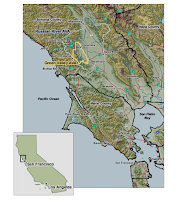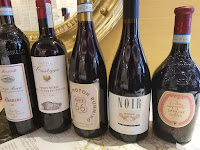
We are continuing our focus on regenerative farming, this time through the lens of Drew Baker and Maryland's Burnt Hill Farm. You can review the tenants of this framework at Regenerative Farming: Why the Fuss?. The Baker family has always been interested in more sustainable farming and winemaking practices since they planted their first vines and opened Old Westminster Winery back in 2011. Five years later, the Bakers partnered with geologist Ernest "Bubba" Beasley to search for the "perfect" hillside to plant a new vineyard. A year later they purchased an 117-acre site that Beasley determined ".. has the potential to grow extraordinary wines".
 This property contains steep slopes and rocky, well-drained soils (composed of phyllite and schist, layered with veins of quartzite). These soils are naturally low in potassium, a mineral that, in excess, can dull a wine’s acidity. Thus these shallow, skeletal soils had the potential for creating fresh, vibrant, and ageable wines. They then spent two years amending the soil by integrating cover crops and biodynamic practices to enhance the soil quality before planting old-world varieties alongside native and hybrid vines in 2019.
This property contains steep slopes and rocky, well-drained soils (composed of phyllite and schist, layered with veins of quartzite). These soils are naturally low in potassium, a mineral that, in excess, can dull a wine’s acidity. Thus these shallow, skeletal soils had the potential for creating fresh, vibrant, and ageable wines. They then spent two years amending the soil by integrating cover crops and biodynamic practices to enhance the soil quality before planting old-world varieties alongside native and hybrid vines in 2019.  Today, "Burnt Hill is a complex system of interacting forces — soil, plants, animals, fungi, and people — all working together in delicate balance". In addition to the grapevines, they raise longwool sheep, woodland hogs, honey bees, log-grown mushrooms, heritage grains, and a small orchard — "always with reverence for the relationships between the land and all things who call it home". The sheep and hogs are alternatives to mowing and assist in pest control and the bees help pollinate the cover crops - which in turn - are layers of armor protecting the soil from sunlight and maintains moisture. And they repurpose as much as possible. When ash trees on the farm succumbed to the invasive emerald ash borer, they were immediately harvested and made into foeders used to ferment and age the wine. Minerals from the property were also collected and made into plates that are now used in the tasting room.
Today, "Burnt Hill is a complex system of interacting forces — soil, plants, animals, fungi, and people — all working together in delicate balance". In addition to the grapevines, they raise longwool sheep, woodland hogs, honey bees, log-grown mushrooms, heritage grains, and a small orchard — "always with reverence for the relationships between the land and all things who call it home". The sheep and hogs are alternatives to mowing and assist in pest control and the bees help pollinate the cover crops - which in turn - are layers of armor protecting the soil from sunlight and maintains moisture. And they repurpose as much as possible. When ash trees on the farm succumbed to the invasive emerald ash borer, they were immediately harvested and made into foeders used to ferment and age the wine. Minerals from the property were also collected and made into plates that are now used in the tasting room.  Burnt Hill is comprised of an assortment of grapevines such as as Cabernet Franc, Cabernet Sauvignon, Pinot Noir, Gamay, Syrah, Merlot, Tannat, Valvin Muscat, plus the unique hybrid Regent. These wines made from these grapes are available through both the Estate wine series and collaboration wines with Old Westminster. And they are only available by participating in a Burnt Hill Farm Experience. And this is a fantastic experience. By reserving a tasting, participants are able to sample a plethora of wines paired with dishes prepared by Chef-partner Tae Strain. These dishes include ingredients from the Burnt Hill orchard, gardens, grains, mushrooms, and animals. A treat indeed. Here's a sampling of wines to expect.
Burnt Hill is comprised of an assortment of grapevines such as as Cabernet Franc, Cabernet Sauvignon, Pinot Noir, Gamay, Syrah, Merlot, Tannat, Valvin Muscat, plus the unique hybrid Regent. These wines made from these grapes are available through both the Estate wine series and collaboration wines with Old Westminster. And they are only available by participating in a Burnt Hill Farm Experience. And this is a fantastic experience. By reserving a tasting, participants are able to sample a plethora of wines paired with dishes prepared by Chef-partner Tae Strain. These dishes include ingredients from the Burnt Hill orchard, gardens, grains, mushrooms, and animals. A treat indeed. Here's a sampling of wines to expect.Blanc de Blancs ($66)
This method champenoise sparkling wine is a collaboration between Old Westminster and Burnt Hill featuring chardonnay grapes grown at Cool Ridge Vineyard. Eventually the wine will be made from Burnt Hill north block estate Chardonnay. In the meanwhile, this is a fantastic expression of sparkling chardonnay - weighty, creamy, nutty, and with a cyclone of green apples.
Earthsong 2021 ($88)
A 93%-7% Pinot Noir - Cabernet Franc blend where the Pinot was fermented in the ash wood foeders. Elegant and rustic old world charm.
2021 Single Barrel Selection RE - 01 Barrel 5 ($105)
See Grape Spotlight: Maryland Regent from Burnt Hill Farm.
Terrafirma 2021 ($88)
Bordeaux-style blend of Merlot (54%) , Cabernet Sauvignon (27%), Cabernet Franc (14%) and Tannat (5%) also fermented in the ash wood foeders (except that the Cabernet Franc was fermented in concrete). This wine is no where near its full potential. Racy acidity and lively dark fruit with plenty of earthy and herbaceous notes.
Gamay Barrel Selection 2021 ($132)
The grapes for this wine were harvested from the estate's north block and fermented in the same ash wood foeders. Loads of juicy minerality and general brightness. Unveiling the site's potential.
Nectar Vin Blanc Doux ($47)
This wine combines the Old Westminster Winery estate Chardonnay with honey made from the Burnt Hill bee collective. An extremely approachable wine - think honey and pears.






































